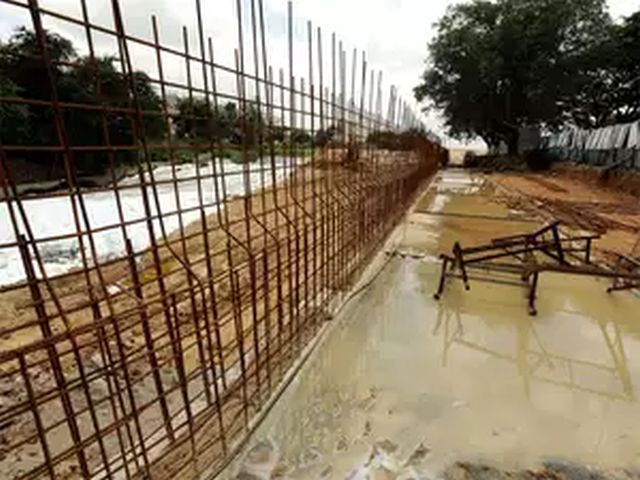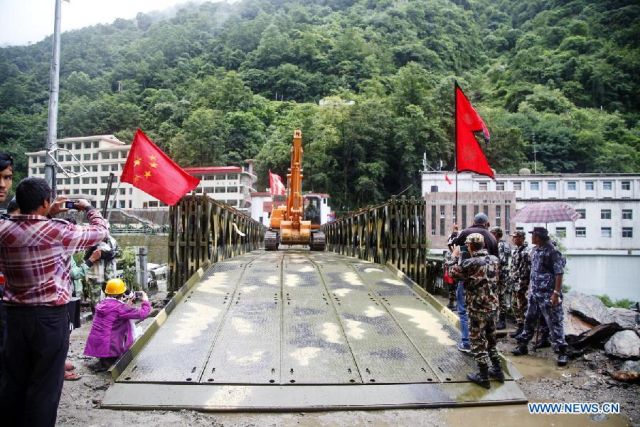
by admin | May 25, 2021 | Investing, World
 By Vishal Gulati,
By Vishal Gulati,
Da Nang (Vietnam) : In a major commitment to advance climate action in developing countries, Canada has pledged $228.79 million towards the new investment cycle of the Global Environment Facility (GEF).
Minister of International Development Marie-Claude Bibeau announced Canada’s pledge for the fiscal 2018-2019 through 2022-2023 to the seventh replenishment of the GEF.
A strong supporter of the GEF and also its sixth-largest donor, Canada reiterated its climate pledge at the Sixth GEF Assembly here in Vietnam, the GEF secretariat said on Thursday.
Developing countries constantly face the destabilising effects of climate change, with women and children facing disproportionate challenges, the Canadian government said in a statement.
Collaboration and partnerships between governments, global institutions, non-governmental and local organisations, as well as the private sector are key to moving forward on climate action.
Canada is committed to these efforts to empower the most at-risk communities to better adapt and mitigate the harmful impacts of a changing climate, it said.
Canada, through the GEF, works with partners to tackle global environmental issues and to support sustainable development, including poverty reduction and gender equality.
The GEF is the single-largest source of funding and a catalyst for action on the environment.
It funds programmes that have brought sustainable land management, benefiting smallholder farmers; provides biodiversity protection and planning for productive terrains and water bodies; and have protected river and lake basins, groundwater basins and large marine ecosystems.
GEF CEO and Chairperson Naoko Ishii told the opening session of its two-day GEF Assembly on Wednesday that humans must transform their key economic systems and move to a circular economy to restore the ecosystems.
“Every day we are receiving wake-up calls from nature; massive loss of forests and lands, species being lost, pollution of air and water. And we are suffering from increasingly visible impacts of climate, coastal cities such as Da Nang are vulnerable, and so are small islands states.”
The GEF was created in 1991 ago to help fight against these threats, she added.
Its assembly is the governing body of the GEF, a mechanism to provide grants for environment projects, and is composed of all 183 member countries.
Since the GEF was established, the initiatives it funded have reduced greenhouse gas emissions by 2,700 megatonnes and introduced more than 50 climate-friendly technologies, leading to energy efficiency, renewable energy generation and sustainable urban transport.
The GEF Assembly met two months after governments, in a demonstration of confidence, approved a $4.1 billion replenishment of its new four-year investment cycle, known as GEF-7.
(Vishal Gulati is in Da Nang for the Internews’ Earth Journalism Network Biodiversity Fellowship Programme at the Sixth Global Environment Facility (GEF) Assembly. He can be reached at vishal.g@ians.in)
—IANS

by admin | May 25, 2021 | Investing, Opinions
 By Taponeel Mukherjee,
By Taponeel Mukherjee,
Perspectives on infrastructure assets vary widely: While investors focus on investment returns, policymakers analyse both financial and socio-economic benefits. It would be worthwhile for policymakers to view things through an investor’s investment prism because an understanding of the critical factors that shape investment decisions will help frame better policies to expedite Indian infrastructure creation.
The “raw value” of an infrastructure project is what a potential investor evaluates first. For example, in a renewable energy wind project, the wind potential of a site is what an investor evaluates. For a transportation project, the investor evaluates the potential passenger traffic. This so-called “raw value” is a huge determinant of the financial viability of a project.
Segregating infrastructure sectors and projects by such “raw value” can help government and industry alike to work towards directing infrastructure capital more optimally. Additionally, such analysis helps in framing policies for those sectors that deliver very substantial social and economic value but are not financially viable on their own.
A robust framework that helps determine “raw value” can aid all the stakeholders, especially the government, to work with investors and multilateral trade agencies to find financing solutions for such socially and economically relevant projects. Eventually, India needs to create an information repository of sorts that provides the global investor base information and access by asset type and investment potential.
Once the “raw value” of a project is determined, an investor tries to gauge what is called its “scarcity value”. Take, for instance, transportation projects. If the transportation potential of connecting City “A” with City “B” is attractive, then is building an airport to connect the two cities the most optimal infrastructure asset? That is, in spite of the traffic potential, is an airport a “scarce” enough asset to deliver attractive returns?
The investor will gauge whether the airport is likely to face competition from a competing train network or a highway. Being cognizant of the long-dated nature of infrastructure assets is important. Hence investors will have to gauge the “scarcity value” of the asset to determine the attractiveness of the asset over the long investment horizon and, therefore, eventually decide on their willingness to invest in the asset.
It is essential for the government to find a balance between allowing investors to make returns commensurate with the risk taken and allowing the public to have access to a well-priced and high-quality infrastructure asset. The twin objectives of consistency and transparency in policy are crucial in this regard.
The government’s ability to formulate and communicate the strategy effectively regarding not just sectors but individual assets is vital. To indeed expedite infrastructure creation, granular policy across industries will be needed, more so for much-needed greenfield infrastructure projects.
Apart from “raw value” and “scarcity value”, an investor considers a third factor: The quality of the underlying contracts signed for the asset. Investors look for high-quality counter-parties with whom to sign contracts. More importantly, the government’s ability to deliver a robust legal system for contract-enforcement, as also a more efficient system for conflict-resolution, will attract more significant investments.
Lowering the risk perception for Indian infrastructure assets is essential not merely to attract more investments but also to attract investments at lower financing costs. Reducing the cost of capital is going to be a significant driver of infrastructure projects through their improved financial viability.
Another area that merits attention is the possibility of the government working even more closely with Export Credit Agencies of various countries to offer foreign exchange hedges, while “importing infrastructure investments”. Solutions that not only reduce the legal risk in investments but also partially eliminate the foreign exchange risk can help boost investments significantly.
Active policies to address the three issues revolving around the value, scarcity and contract enforcement that investors utilise to determine both investments and the required rate of return can help make policies useful.
Policy frameworks can potentially be refined using these three key factors that shape investment decisions. Most importantly, one does not need to improve concurrently on all three fronts for all infrastructure sectors; incremental improvement on one element can provide a significant fillip to infrastructure investments.
(Taponeel Mukherjee heads Development Tracks, an infrastructure advisory firm. Views expressed are personal. He can contacted at taponeel.mukherjee@development-tracks.com or @Taponeel on Twitter)
—IANS

by admin | May 25, 2021 | World
 Kathmandu : Nepal is willing to enhance cross-border railroad connectivity, infrastructure development, trade, investment and tourism cooperation with China under the framework of the Belt and Road Initiative, Prime Minister K.P. Sharma Oli, said here ahead of his visit to Beijing.
Kathmandu : Nepal is willing to enhance cross-border railroad connectivity, infrastructure development, trade, investment and tourism cooperation with China under the framework of the Belt and Road Initiative, Prime Minister K.P. Sharma Oli, said here ahead of his visit to Beijing.
Oli, who will embark on a five-day visit to China on Tuesday, told Xinhua during an interview that the Himalayan nation is fully committed to implementing the Memorandum of Understanding (MoU) on cooperation under the framework of the Belt and Road Initiative signed with China two years ago.
His government has formed a mechanism to implement projects under the Belt and Road Initiative and various ministries are working for the same target, the prime minister said.
Our two countries have common views on the concept of Trans-Himalayan Multi-Dimensional Transport Network. Based on this broad framework, we want to seek cooperation with China on cross-border connectivity of railway, road, transmission lines and other related areas for mutual benefit,” Oli said.
Nepal has viewed the Belt and Road Initiative as an important development initiative, he said.
The Prime Minister said Nepal has recently proposed some projects in the areas of roads, railway, energy, transmission line for cooperation with China.
While talking about Nepal’s ties with China, Oli said it attaches great value to its relationship.
“China is our immediate neighbour. Our two countries share a long history of friendly relations which are multifaceted and deep rooted.
“Our relations are based on the solid foundation of the Five Principles of Peaceful Coexistence,” he said.
During his visit, Oli will meet Chinese President Xi and Premier Li Keqiang and other senior Chinese leaders in Beijing. He will lead a 100-plus delegation.
This is his first visit to China after coming to power in February.
—IANS

by admin | May 25, 2021 | Business, Economy, Emerging Businesses, Investing, Markets, News
 Chennai : German consumer durable major BSH Hausgerate GmbH will invest about 100 million euros in India for a new refrigerator plant and also towards expansion, technology, marketing and brand building, said a senior company official.
Chennai : German consumer durable major BSH Hausgerate GmbH will invest about 100 million euros in India for a new refrigerator plant and also towards expansion, technology, marketing and brand building, said a senior company official.
“Over the next four or five years, we will invest 100 million euros in India into products, facilities and research and development (R&D),” Michael Schollhorn, Chief Operating Officer told IANS here.
“Globally, per year we invest about 650 million euros into projects and other activities.”
Schollhorn was here in connection with the laying down of the foundation for the new refrigerator plant next to its existing washing machine plant in Sriperumbudur.
“The investment in the new refrigerator plant will be 50 million euros and the plant will make 500,000 units per annum,” Rudolf Walfort, Regional Operations Officer – Asia Pacific, BSH Household Appliances Manufacturing Private Ltd told IANS.
Currently importing and outsourcing the top end refrigerators, BSH Household Appliances will make the mass market products at its new factory expected to go on stream by 2021.
Till date the 13.8 billion euros revenue German group has invested about 100 million euros in India that includes a 300,000 units per annum washing machine plant.
Schollhorn said that India was one of the fastest growing household appliances markets.
“Though Europe continues to be our major market, four years ago the group decided to grow in other regions,” Schollhorn said.
The German company wants to make its Indian subsidiary BSH Household Appliances Manufacturing Private Ltd a significant player in the domestic consumer durables market.
“In the refrigerators our focus will be on the twin door products with 260-360 litre capacity. The products will be priced competitively and designed for typical Indian usage,” Gunjan Srivastava, Managing Director and CEO, BSH Household Appliances told IANS.
According to Srivastava, by 2025 the company will have a double digit market share in the domestic refrigerator market.
“Currently the Indian refrigerator market size is about 10 million units,” Srivastava said.
In the Indian market, BSH Household Appliances is present in the washing machines (front and top loading), cooking range, dishcare and built-in appliances.
Srivastava said the washing machine capacity will also be expanded by 200,000 units to 500,000 units per annum.
On the distribution side, he said the company’s products are available in 250 cities and it will be expanded as the market grows.
—IANS

by admin | May 25, 2021 | Business, Commodity Market, Emerging Businesses, Investing, Markets, Technology
 San Francisco : Playing a crucial role in future research and development (R&D) of a revolutionary aluminium smelting technology, Apple has committed investment in a joint venture that resonates the iPhone-maker’s take on environment-friendly technology innovations.
San Francisco : Playing a crucial role in future research and development (R&D) of a revolutionary aluminium smelting technology, Apple has committed investment in a joint venture that resonates the iPhone-maker’s take on environment-friendly technology innovations.
The joint venture could change global manufacturing. Aluminium is a key material in many of Apple’s most popular products and for more than 130 years, it’s been produced the same way. But that’s about to change, the company said in a blog post late on Thursday.
Aluminium giants Alcoa Corporation and Rio Tinto Aluminium announced the venture called “Elysis” to commercialise patented technology that eliminates direct greenhouse gas emissions from the traditional smelting process — a key step in aluminium production.
Apple has partnered with both aluminium companies and the governments of Canada and Quebec, to collectively invest a combined $144 million to future R&D.
“Apple is committed to advancing technologies that are good for the planet and help protect it for generations to come,” company CEO Tim Cook said.
“We are proud to be part of this ambitious new project, and look forward to one day being able to use aluminium produced without direct greenhouse gas emissions in the manufacturing of our products,” he added.
Aluminium smelting process involves applying a strong electrical current to alumina, which removes oxygen. Companies use a carbon material that burns during the process, producing greenhouse gases.
Alcoa Corporation designed a new process that replaces that carbon with an advanced conductive material and instead of carbon dioxide, it releases oxygen.
“Elysis” would work to further develop this technology for larger scale production and commercialisation, with a package planned for sale beginning in 2024.
The company would continue to provide technical support as well, Apple said.
—IANS





